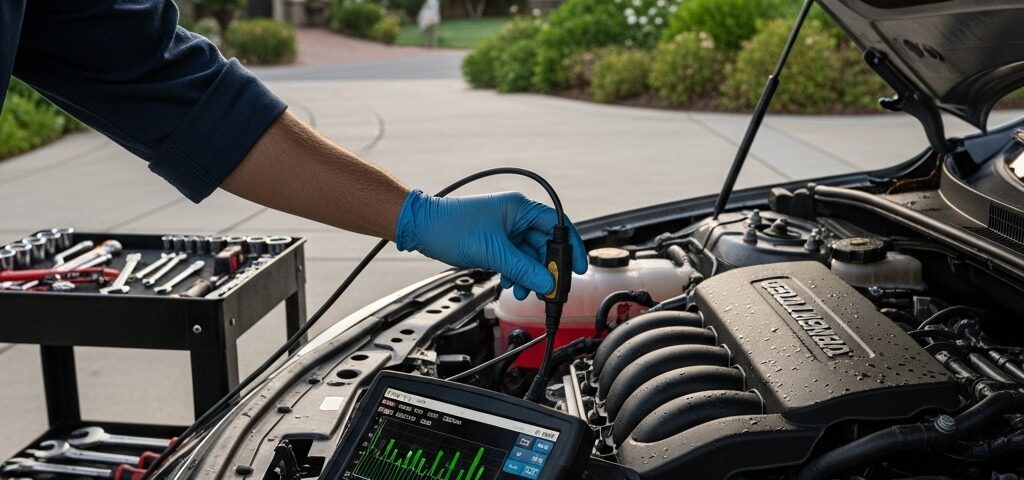
Car Repair For Brake Pads And Rotors In Thousand Oaks California
October 5, 2025
Transmission Repair Near Me in Thousand Oaks California
October 5, 2025A check engine light in Thousand Oaks can feel like a riddle: sometimes it glows steadily after a peaceful drive down Hillcrest, other times it flashes the moment you pull onto the 101. Between our warm afternoons, cool canyon mornings, and mixed city–freeway routines, engines here experience a wide range of operating conditions in a single week. Good diagnostics translate those conditions into answers, not guesswork. That is the heart of our approach. We begin with the story you tell, pair it with data from professional tools, and test until the cause is clear. It’s the same standard people look for when they seek reliable car repair for their daily driver or weekend cruiser in the Conejo Valley.
Effective engine diagnostics are less about replacing parts and more about understanding why the car behaves the way it does. An oxygen sensor code, for example, might reflect an air leak upstream, an aging catalytic converter, or fuel trim drift caused by a small vacuum issue. A misfire code might point to ignition components, but it can also result from injector performance, compression variability, or even a subtle coolant leak. Sorting these possibilities demands patience, a clear test plan, and the discipline to confirm each hypothesis before moving on.
Listening to the driver, then to the data
We start with your description, because symptoms often carry clues a scan tool can’t see. Is the rough idle more noticeable on cool mornings in a shaded driveway? Does the stumble appear only after a long downhill coast into town? Do you smell fuel after parking at the Oaks Mall? Each detail narrows the path. Once we have the context, we connect scan tools, record live data, and look at patterns: short- and long-term fuel trims, misfire counters per cylinder, oxygen sensor switching behavior, and throttle and airflow signals under different loads.
From there, we perform targeted tests. Smoke testing finds air leaks a code may only hint at. Oscilloscope measurements reveal sensor behavior in real time, separating a bad signal from a bad sensor. Compression and leakdown tests compare cylinder health. When the evidence lines up, we explain the cause in plain language and outline options that fit your goals for the car.
The Thousand Oaks effect on engines
Local geography and weather shape engine behavior more than most drivers realize. Warm afternoons increase intake air temperature, shifting density and influencing fuel strategy. Morning dew and cooler air in shaded neighborhoods can change idle quality and accentuate small ignition issues. Steady freeway runs toward Ventura keep components hot and clean, while short trips to schools and shops can encourage carbon buildup and moisture in exhaust systems. We account for these factors when interpreting data so we don’t chase ghosts or overlook simple truths.
We also pay attention to how you use the car week to week. A vehicle that spends most of its time in gentle suburban loops may need different maintenance timing than one that sees regular climbs and descents in the canyons. The more accurately we map your routine, the more precisely we can tailor diagnostics and solutions.
Misfires, fuel trims, and the path to clarity
Misfires can be loud or quiet, obvious or elusive. If a misfire appears only under load on the 23, we look at ignition strength, coil behavior, plug condition, and fuel delivery, then confirm with a controlled road test. If it shows at idle after a cold start, vacuum leaks and sensor drift move higher on the list. Fuel trims tell a parallel story. When the engine adds fuel consistently, we think air leaks, low fuel pressure, or metering inaccuracies. When it pulls fuel back, we consider leaking injectors, rich biasing sensors, or evaporative issues. The key is to match data with symptoms until a single narrative emerges.
Catalyst efficiency codes are another local favorite, often tied to driving patterns. Short trips may not keep converters hot enough for long, triggering codes that a highway run might temporarily clear. Rather than guessing, we measure oxygen sensor activity, heat behavior, and exhaust flow. If a converter is truly marginal, we explain why and how other systems contributed so the fix is complete, not partial.
Electrical integrity: grounds, connectors, and reality checks
Many engine faults hide in the spaces between components: a ground with a touch of corrosion, a connector that loses contact when hot, or a harness that rubs against a bracket near the radiator. We check these basics because they derail otherwise logical diagnostics. A failing sensor looks guilty on paper until a wiggle test shows the signal drop is from a loose pin. Protecting your budget means verifying the pathway, not just the parts.
Battery health and charging performance matter too. A borderline battery can skew sensor references and module behavior, especially after cool nights. We test voltage stability during start and under load so the data we rely on is trustworthy. It’s simple, disciplined work that keeps the process honest.
When repair meets prevention
Once the cause is clear and the repair is complete, we look for ways to keep the issue from returning. That might mean adjusting maintenance timing for local conditions, recommending fuel quality that suits your engine’s needs, or suggesting occasional highway drives to keep systems hot and clean. It may also include software updates when manufacturers release improvements that refine idle, shifting, or emissions strategies.
We document baseline readings so future visits have a reference point. If fuel trims were near zero after a repair, and a year later they drift positive again, we know where to look first. This continuity saves time and builds confidence that your car is trending in the right direction.
Communication that removes the mystery
Diagnostics can feel opaque if all you hear is jargon. We replace that with clear explanations and visual proof where helpful. If we found a vacuum leak at a particular hose, you’ll see a photo and hear the logic that led us there. If a sensor’s signal was inconsistent, we’ll show the trace and outline why replacement is warranted. Clarity is not a luxury; it is part of the repair. It ensures you understand what was done and what to expect next.
We also respect your schedule. Appointments are structured around your day, and updates arrive in the format you prefer. If a test requires more time, we set expectations and offer options so you can plan around the car without stress. A calm process leads to better decisions and better outcomes.
The value of local road testing
Replicating your symptoms matters, which is why we road test on the same types of routes you drive. If the stumble appears climbing toward Lynn Road, we go there. If it shows up after coasting down into Westlake, we mimic that descent. Real-world testing validates the fix and ensures the engine behaves the way you expect where you actually drive, not just on a generic loop.
Temperature is part of that plan. Some issues emerge only after heat soak, while others show during the first minute after a cold start. We schedule tests accordingly, sometimes keeping the car overnight to capture the morning behavior you described. Patience here avoids repeat visits and turns a nagging light into a solved story.
Frequently Asked Questions
Q: My check engine light is on but the car seems fine. Should I worry?
A: A steady light often means a non-urgent emissions or sensor issue, but it still deserves timely attention. Codes can stack or mask one another, and catching the first sign prevents side effects. We’ll scan, test, and explain what’s safe to monitor versus what needs action now.
Q: Why do codes come back after I clear them?
A: Clearing codes removes the symptom, not the cause. If the underlying condition remains—like a vacuum leak or weak ignition component—the code will return once the system runs its checks. The solution is precise testing and a repair that addresses the root problem.
Q: Can short trips around Thousand Oaks cause diagnostic headaches?
A: Short, gentle drives can prevent systems from reaching full operating temperature, encouraging moisture and carbon buildup and delaying readiness monitors. We factor your driving pattern into diagnostics and may suggest occasional longer drives to complete tests and keep components clean.
Q: How do you differentiate a bad sensor from a wiring issue?
A: We verify signal quality with scopes, compare readings against known-good values, and perform wiggle and load tests on the wiring. If adding a controlled load makes the voltage drop, the wiring is suspect. If the signal is erratic despite solid power and ground, the sensor is likely at fault.
Q: What if my engine problem is intermittent?
A: Intermittent concerns require patience and replication. We log data over time, test under the conditions you describe, and keep notes so patterns emerge. It may take a bit longer, but it prevents replacing parts blindly and produces a lasting fix.
Q: Are software updates part of diagnostics?
A: They can be. Manufacturers release updates that refine how modules interpret sensors and manage fuel, air, and spark. If your vehicle qualifies and the update addresses your symptom, we include it in the plan so the repair isn’t fighting outdated logic.
Ready to turn that warning light into a clear plan?
If your engine has been sending signals—lights on the dash, a new hesitation, or a change in idle—let’s translate them into answers. With careful testing and local road knowledge, we’ll uncover the cause and map a solution that fits your schedule.
Reach out to schedule a diagnostic visit and get your car back to its calm, confident self. For precise, local-first car repair, we’re here to help you drive Thousand Oaks with peace of mind.


